|
| The
Qaanaaq Region |
| Upernavik
to Qaanaaq : Previous leg << News
Index >> Next episode : to come
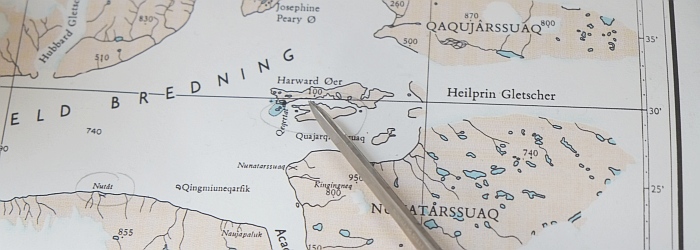
|
|
Chart of Harward Oer and Qeqertat (© Kort & Matrikelstyrelsen,
Miljoministeriet, Danmark) |
Autumn 9: It's
dark (November 30th, 2015)

If you can read this message, we have re-established communication
with Qaanaaq. Since nearly three months we have been cut off
from the world. The absence of infrastructure has impeded
any communication with the outer world during the period in
which the ice was forming.
This lack of communication did not stop us from filming,
taking pictures and writing about our experiences. With more
or less delay you will be able to discover the period in which
Nanuq transformed from sailing yacht 'umiaq' to 'igloo' and
got frozen in by the ice since our last post on the September
28th - 'immaqa' - in chronological order:
It is dark ...
... the temperature has dropped bellow -30°C. The average
temperature for the winter months in Qaanaaq is -25°C;
in Qeqertat it is two degrees less than in Qaanaaq and in
'Nanuq's Cove' three degrees less than in Qeqertat. The full
moon, which never sets, gives us a day without night. A thin
layer of powder snow, which shines and sparkles in the light,
covers the landscape: Blue Moon! Magic!
Nanoq - the polar bear - has been seen several times in the
West. It's the fifth that tries to make it's way up the fjord.
We double our care. Accompanied by Sara, our dog, a gun and
powerful headlamps we venture out to explore the region in
this new light. Tomorrow we will transfer part of our dog
food onto the ice, a short distance from the camp. This will
allow the bear to have a feast and leave us alone, at least
for a while.
The outside work is finished. We have installed the weather
station that measures and logs meteorological data: wind,
solar radiation, albedo, air and water temperature and the
heat flux that goes through the ice (see science
page). The batteries that were intended to supply the
installation with electricity do not resist the cold. Therefore
we have moved the station close to the boat (50m) and connected
it to our main electrical system.

Twilight at miday: Nanuq and the weather
station (photo Kalle Schmidt)
Everything is ready to welcome the cold. The excellent thermal
insulation and the relatively warm temperature of the water
below the ice-shelf provide a thermal balance requiring very
little energy to make a comfortable dwelling. During the 'day'
the heating works intermittently to maintain a pleasant temperature
inside the cabin. When we sleep, the heating is turned off,
activities stop and the temperature progressively establishes
itself around 5°C in the cabin and 0°C in the sleeping
quarters. The warm sleeping bags create a warm and cozy bubble
around us and guarantee a good night sleep - no need to fight
to keep warm.
The heat recovery system is most amazing. The screen shot
below shows mesurements on a typical day (-30°C). Supply
air enters the cabin at almost indoor temperature, using only
a few Watts for the ventilators. The fresh water condenser
has not been installed due to the close to zero exhaust air
temperature and easy supply of fresh water from the nearby
lakes, as long as available since ice is getting thicker every
day...
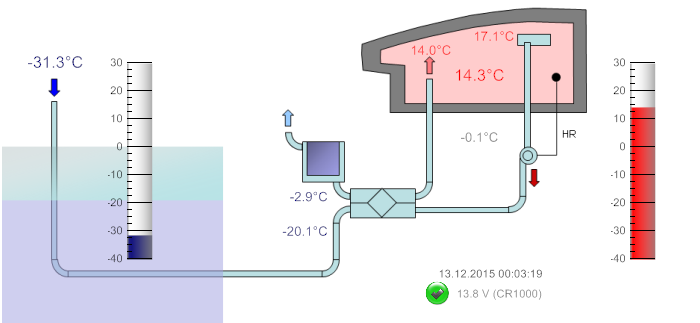
The passive igloo project - screen capture
of RTML interface (Logernet). Fresh air (-16.2°C) is preheated
through an imerged pipe in order to reduce icing of the counter
flow heat exchanger (-10.1°C). A humidity sensor (HR)
controls the air change rate. The fresh preheated air is intruduced
into the cabin at close to heating temperature (16.8°C).
Exhaust air quits the boat at close to freezing temperature
(1.3°C). (by Peter Gallinelli)
With the arrival of the cold, the 'passive igloo project'
gets to it's operational stage. The goal is to spend an
arctic winter in complete self sufficiency and without use
of non-renewable energy sources, to explore the possibilities
and the limits of the passive dwelling of tomorrow. The objective
is not to achieve this goal with unlimited resources, as this
would be an exclusive luxury. Instead we try to drastically
reduce dependence from non-renewable energies exploring robust,
affordable, simple and comprehensible solutions.
'A good solution is a solution one can forget about'. Although
it is still too soon to draw conclusions on all the systems,
the reinforced thermal insulation is without a doubt part
of the good solutions.
Our fuel consumption is minimal considering the biting cold,
the absence of wind and the simplicity of the systems: an
excellent insulation, a wind generator and a heat exchanger:
50 liters for one month of comfort. Heat pump and warm water
storage had to be abandoned due to our tight budget. A first
analysis indicates that over the past month, the primary energy
consumption has been of 250W/person. This energy is used for
heating, lighting, electrical equipment, warm water and cooking.
This is 10 times less than the swiss average. And we are in
the arctic with an average temparature of close to -20°C!
Above 0°C (the average temperature in January on the swiss
plateau) the heating system, also the biggest energy consumer,
is no longer needed. The coming winter will allow us to study
and learn about how these systems perform in the long run
in very cold conditions. And we are looking forward to it!
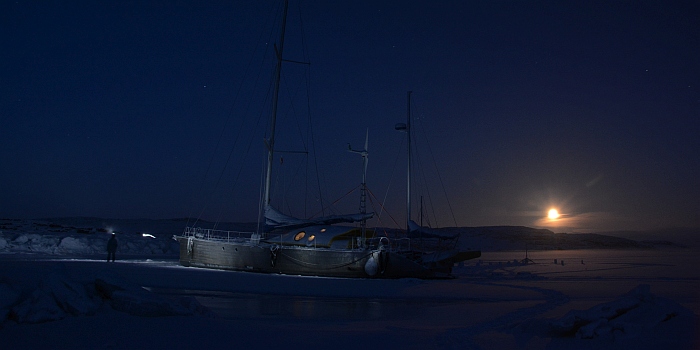
Blue Moon: full moon (or nearly) over
the ice. Nanuq is in her element. November 25th | 77.5°N
| -25°C (photo Kalle Schmidt)
Hence we are heading into the cold, gloomy and magic arctic
winter. This will probably be our last message before the
end of the year. It will begin its voyage tomorrow when we
visit the village; a road with many uncertainties. Our home
is onboard Nanuq, no possible return.
So we look ahead, towards the adventures to come. We still
have to install some sensors that will do an objective observation
of what we live in a perfectly subjective manner. The two
methods complete each other. We are here to learn about the
dwelling and its inhabitants - us - in an extreme
environment.
For us, Team Nanuq, the idea of passion is about experiencing
new colours and flavors, discovering new places, meeting new
people, being in close contact with nature and exploring our
own limits. What
drives us is the possibility to experience, the urge to try
new things and the curiosity to understand - and this is exaclty
what we do.
The ongoing challenges are:
- Sleeping patterns - our natural rhythm shifts later 45min
per day...
- Energy management with no wind at all (10 days+)
- The communication with Qaanaaq and the rest of the world
But, everything goes well onboard :-)
We wish you joyful Christmas period and a beautiful winter.
Bai- takussagut (*)
Peter & crew
(*) Kalaalit ('baï takouch') = see you soon
Autumn
8 : Work on the ice (November 20th, 2015)
The barometric pressure drops drastically and we experience
the third storm from the South. After a period where we got
a small taste of winter (-20°C) and the first northern
lights, the sky is low and the wind blows with gusts up to
50 knots. The temperature is positive. The wind brings temperate
air from far away. Free from landlines, Nanuq rests well protected
in her frozen cradle. The gusts make us heel a few degrees,
hardly noticeable. Our 'mooring' is perfect!
Rigid like a piece of metal sheet a few days ago, our dinghy
becomes soft again, and we take advantage from the warm conditions
to fold it and store it away. Now useless, it was of great
use to us during the periods of high tide (approximately 3
meters during spring tides), as the ice close to the shore
was not as developed. As for now we can cross the delicate
zone jumping from one ice cake to the next, making sure not
to sink into the soft ice in between.
We have finished installing the prototype for the ventilation
system. On the one hand there is the need for oxygen inside
the cabin, on the other side there is humidity which has to
be evacuated. Otherwise the inside of Nanuq would fast turn
into a humid and uncomfortable 'cave'. Uncontrolled ventilating
would lead to cold air invading our haven of heat. Therefore
we use a heat recovery system. The system uses the heat from
the sea water (-1.5°C) to preheat the much colder incoming
arctic air (-20/-40°C), which will then, by means of an
heat exchanger, be heated by the inner warm and humid air
which is to be evacuated. The regulation of this process is
done according to the inside air humidity. It is a good and
simple indicator of human presence and activity inside of
the cabin. And it works splendidly! We are curious to learn
from future experience.
Our visitors are intrigued by the installation half way between
technology and tradition: the “buried” pipe is
submerged 2m under the ice in the same manner as a fishing
net, held by small strings attached to ice clamps (can be
seen on the picture).
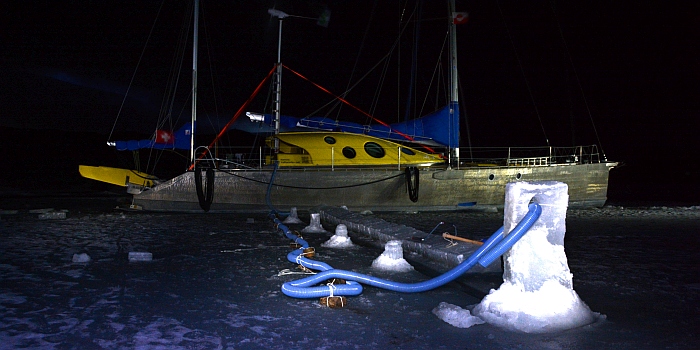
Work on the ice: installation of the
“buried” pipe used to preheat the incoming air.
The bloc on the right is used to hold the air intake in place.
It gives an idea of the ice thickness at the time. With the
cold the blocs freeze together. (photo Kalle Schmidt)

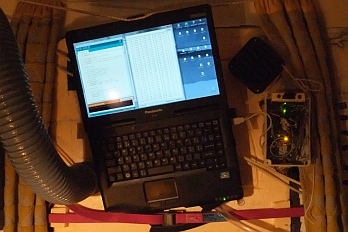
Work with the headlamp: with a cloudy
sky, there is only a very slight twilight. On the right: in
front of the heat exchanger, the computer and the micro controller
that control the ventilators and the system that prevents
condensation inside the system from freezing. (photo Peter
Gallinelli)
The challenges for the moment are:
- Humidity inside and around the boat - salty environment,
drying, condensation, cold spots
- Hygiene and laundry - washing and laundry need a lot
of energy and water, and produce a lot of humidity
- Food - “good food brings good mood” and vitamins
are important, even with a limited resources.
- Energy - managing our limited energy supply due to very
slight winds.
Today there is abundance. There is plenty of wind and the
wind generator turns at full speed. We manage to heat and
completely dry the cabin with small electric radiators. We
have had a period of relative calm, so we are enjoying the
situation. We are counting on a weekly load to keep our batteries
charged…
The transition is complete. Nanuq is ready for the winter.
Autumn
7 : Twilight in Qeqertat (November 7th, 2015)
We experience another Sunday in the paradise of ice. Our
universe does not stop transforming itself. As by now the
day has become twilight. For the past days, the thermometer
has been indicating -20°C and continues dropping. The
ice grows fast at this temperature and we can now move freely
across the bay. It is time to get our legs used to walking
on the slippery ice. We discover muscles we never thought
we had.
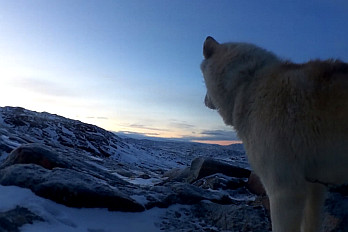

Walk on the recently formed ice: 20cm to safely move on the
ice. (photo Peter Gallinelli)
With the fresh ice we are happy to receive our first visits
from our friends from the village! Our crew has increased
with the arrival of a new member: Sara, the dog that the young
girl from Qeqertat by the same name borrows us for the winter.
She and her father come regularly to join us for “kaffi”
onboard. It’s a great opportunity to improve our Greenlandic!
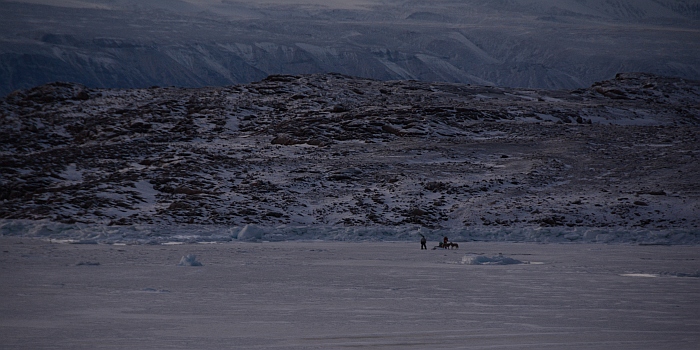
Hunting and fishing on the ice has started (photo Kalle Schmidt)
We join Thomas to install his seal net and are impressed
by the simplicity and efficiency of his device; no tool is
excessive. We witness a life illustration of a quote by Saint-Exupéry:
“It seems like perfection is achieved not when there
is nothing more to ad, but when there is nothing else to be
taken away…”. E = mc2 was not written in one day.
Identically it took many generations of hunters to perfect
this technique. We have a lot to learn from these astonishing
and loveable people.

Scientific programme: installation of the PCBs on the ice
(photo Kalle Schmidt)
This Sunday we install the PCB absorbers. The material, prepared
by the the University of Savoie,
is easy to install even with biting cold. To attach it to
the ice we pour liquid water on the feet of out poles, which
freezes immediately - in the same way as the locals! The installation
will stay at the same place during the whole winter. The analysis
will be done next year, on our arrival in Europe.
We have prepared the “pulkas”. They are much
appreciated to transport the precious drinking water that
we fetch in one of the numerous lakes 1km away froth boat.
It is far more efficient than carrying 80kg on our backs.
After a day outdoors, we welcome the comfort onboard Nanuq;
a warm tea and a large meal to reconstitute the calories burned
before.
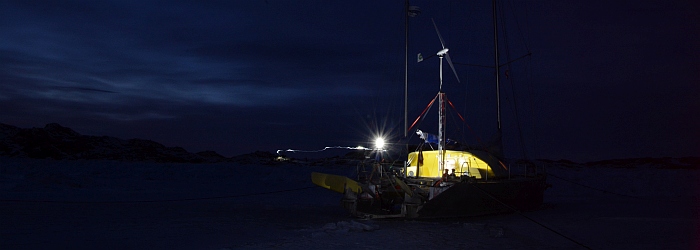
Nanuq in her ice cradle - November 8th.
The rudders are tilted upwards to avoid being exposed to the
pressure of the ice. (photo Kalle Schmidt)
What does the arctic night look like?
You may try to imagine the arctic night with interesting
information concerning sunrise, sunset, moonrise, moonset
and twilight in the tables here below.
There are 3 types of twilight:
 image
from Wikipedia image
from Wikipedia
Civil Twilight: from sunset to the time
at which the sun is 6° below the horizon. At this time,
there is enough light for objects to be clearly distinguishable
without artificial illumination. Civil twilight is the definition
of twilight most widely used by the general public.
Nautical Twilight: the time when the centre
of the sun is 12° below the horizon, and only general
or vague outlines of objects are visible, when it becomes
too difficult to perceive the horizon. This term goes back
to the days when sailing ships navigated by using the stars.
The use of a sextant to measure the altitude angle of stars
required horizon visibility.
Astronomical Twilight: the time at which
the sun is 18° below the horizon. It is that point in
time at which the sun starts lightening the sky. During the
evening, this is the point where the sky completely turns
dark.
Light is of course only available when the sky is clear...
Source of data : U. S. Naval Observatory, see http://aa.usno.navy.mil/data/docs/RS_OneYear.php
Autumn
6 : Here we are (November 5th, 2015)
This our planet...

Icescape with full moon: it doesn't
set; it points us to the North (photo Peter Gallinelli)
The beginning of November marks the last sun. Most of the
day is lit by twilight. The days, being shorter each time,
are an always changing spectacle of pastel colours. The cove
where we are moored in is now completely frozen in. We have
the feeling that we have landed in some remote crater somewhere
in the vast Universe. Nanuq looks like a stranded spacecraft
on an interstellar voyage. Equipped with ingenuity and resources,
she allows us to live in this hostile and exceptional environment.
10 months of solitude separate us from the moment when the
ice will clear and allow us to move into open water again
and make our way back ... towards our world.
The temperatures vary between -10 and -20°C. A freezer!
We work outside huddled in warm jumpers, jackets and dry-suits.
From far away, equipped like this, we look like astronauts;
except for the lack of breathing equipment, for we are lucky:
the atmosphere of our planet is breathable.

Nanuq securely moored in 'Nanuq's Cove'
- watch out for the drying rocks in the middle of the bay
(photo Kalle Schmidt)
The feeling of loneliness is overwhelming. Except from a
rescue operation there is no way back. Until the ice is strong
enough, we live in some kind of isolation from the outer world.
We rely on our resources. The voyage takes a turn towards
becoming an autonomy lab - everything has to be done with
the limited resources on board and what nature is willing
to offer. The only unlimited resource is our creativity.
For example, the notion of waste has nearly disappeared.
We don't have much space to store it anyhow. But also, these
materials can be useful in many ways. A light bulb in a jam
glass becomes a source of heat to keep our compost warm. An
insulation panel becomes a polyvalent building material. Many
parts and pieces come from reutilizing what we might no longer
need or others have discredited as useless. Slowly, through
necessity, we learn the art of doing more with less so familiar
to the Inuit culture, capable of transforming with genius
simple materials into objects with an exceptional value. What
a contrast to the consumerist world, which throws away!
Even the exhaust air from the cabin is recycled. A few days
ago we installed our heat recovery system. The heat and the
humidity from the inside air become a valuable resources.
The water, which is formed through condensation inside of
the heat exchanger, rejoins our fresh water supply, very valuable
in the arctic. The heat from exhaust air is used to pre-heat
the fresh cold air coming in from outside. A micro-controller
is in charge of regulating the air flow by ventilating no
more than is needed and of keeping the heat exchanger free
of ice. This equipment is one of the developments made for
the passive igloo which will undergo testing during
the winter. The only thing that is left to be installed is
a thick hose to preheat fresh air from the outside through
seawater. Below the ice, the seawater temperature never drops
below -2°C - rather warm when it gets really cold: -30°C...
Passive features, such as thermal insulation or low-e glazing,
are so efficient and discrete that we almost forget them.
They are simple and essential parts and the expedition would
be impossible without!
To be continued...
Autumn 5 : Harward
Oer - the freezing sea (October 28th, 2015)
Slowly Nanuq transforms from the Umiaq, the boat,
to the Igloo, the home, as the Inuit call their dwellings.
Installations, rearrangements and cleaning up fill up most
of our days. Our TODO-list becomes shorter each day.
We also make surprising discoveries: some condensation has
appeared in unexpected places. We add insulation to these
areas as well as we can. Therefore our ventilation system
takes an even more important role, as well as keeping vapour
sources under control: cooking, washing and ourselves.
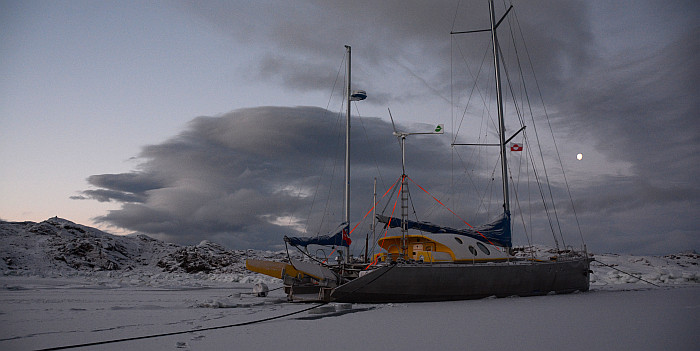
Our vessel, stranded on a wild planet
- Nanuq in the arctic (photo Kalle Schmidt)
The big wind generator has found her place on deck. She has
started to produce her first kWh. We are marvelled to see
this machine transform wind, an unlimited natural element
to our disposition, into precious electricity. We wish for
abundant wind. Are we at the right place for our hopes to
come true? The little data concerning wind patterns do not
allow us to make a reliable forecast. We will have to adapt
to what we get, whether it'll be as we hope ... or the opposite.
Our fresh food supply is slowly coming to an end and now
creativity is asked for! We have dried pulses, rice and starchy
food as our basis. It is time to create nourishing and varied
dishes with our limited ingredients. Except for rare occasions
we have eliminated pasta - popular dish as it is appealing
and easy to prepare - since it uses far to much water and
energy to be prepared, as well as producing tons of vapour.
We prepare different soups with beans, lentils, and chickpeas.
They are easy to be prepared in our pressure cooker. The only
thing we have to think of is putting them into water the day
before. Seems not to much to ask! We rediscover an ancient
art of cooking, a delicacy. To give a range of tastes to our
ingredients, we appreciate the different spices we have in
considerable quantity.
Every Sunday we bake 2kg of fresh bread for the week - a
moment in which our igloo fills with the delicious smell of
freshly baked bread and becomes cosily warm due to the heat
produced by the oven. For bigger occasions a cake or a pizza
is added for a change. Except for the lack of fresh vegetables
and fruit, our menu lacks of nothing from our terrestrial
cuisine. The time for fishing has not yet arrived. But soon
the sea below the ever-growing ice will provide us with the
ingredients that constitute the base of the traditional Greenlandic
diet.
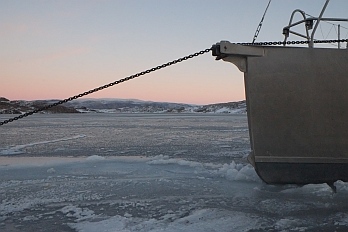
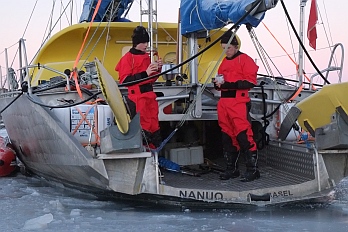
Ice - at last! Nanuq becomes the 'igloo'
(photos Peter Gallinelli)
Thickness of the ice: 15 cm. We are temporarily restrained
from our visits to our friends in Qeqertat as we don't dare
to play icebreakers with our inflatable dinghy. The ice allows
us to take a few steps around the boat, with care and always
in company of our dinghy that we pull behind us, just in case
the ice should not hold our weight...
Autumn
4 : Stormy Bay (October 25th, 2015)
Tonight we have not closed an eye. Ready to jump out of our
sleeping bags we take part in the spectacle given by mother
nature: a symphony of whistling in the rig, the hull scraping
in her ice cradle and bumping against the edges, cracking
of breaking ice, a loose band whipping the deck, an object
sliding when the boat leans with a strong gust, the landlines
solidly installed around rocks cracking on their clamps. Big
clouds of snow and dust pass over our hatches. From time to
time we switch on the deck light to check that we do not drift
away - we don't know yet how boat and ice behave - also to
check if our dingy is still there; we have fastened it upside
down on leeward of the boat after it tried to fly away a few
times - it seems to be behaving now.
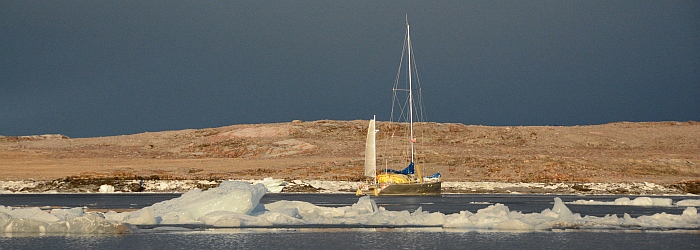
Arrival at 'Stormy Bay'' (photo Kalle
Schmidt)
It's just one more of the southerly storms that leash their
force on this region. We were introduced to them during the
first days in the apparently sheltered bay, which we originally
had thought as being our winter camp. We had been warned about
strong winds on the ice cap. The wind speed for our region
was forecasted to be 35 knots, a gale easily handled. We believed
it for a moment: two anchors and two landlines seemed perfect.
...our opinion changes drastically when the first gusts arrive
as if Thor had swung his hammer at us himself. Just in time
we let go the landlines and the anchor, to moor a little further
into the bay. It was then that the real storm began. In spite
of the excellent hold of our anchor, it becomes impossible
to resist to more than a few gusts before it would leash.
Gust after gust, easily 60 knots, fall over us. The strongest
gust exceed 70 knots - our mooring stands no chance. We start
the engine at once!
It's dark around us. We take down the mizzen sail, otherwise
it will be torn away. The wind howls and it is impossible
to communicate on deck. The only way the other hears is by
shouting at full pitch 2 m from each other. Without any sail
surface, Nanuq heals at each gust. The side deck dips into
the water. The visibility is only a few meters. Everything
is white. The wind has become a hurricane. It tears the water
from the sea which has transformed into white foam. The limit
between air and water is uncertain. We are on deck, soaked
to our teeth, making rounds on the water while waiting for
some calm. We are not eager to end up on some shoal and spend
the winter there.
Although the wind doesn't give us a single moment of rest
there are some advantages to our situation: the warm temperature
(0°C); these wind conditions in lower temperatures would
have been much harder, the full moon allows us to see the
shadow of the coast in the dark and our little bay is well
protected from the open sea. After a strong gust, we just
have enough time to make our way towards the wind beating
backwards. Luckily Nanuq has no hard time of sailing against
the wind, which allows us to reposition ourselves after especially
darting gusts. The diesel engine runs smoothly as if nothing
was happening. Reassuring!
With the first daylight, the wind turns to the South, allowing
us to moor ourselves back to the landlines. It is a delicate
but successful operation. As soon as we are belayed on our
port clamp, another gust falls over us. Nothing happens, we
are at the same place as before: oufff! Now it's time to recharge
our batteries. Adrenaline is an amazing resource. Whereas
we did not feel tiredness, hunger or cold while on deck, now
we have to rest. We sleep, keeping watch in turns. The gusts
become less strong. Only a few set off the alarm, which is
set to 60 knots. As the day goes on, the wind slowly settles.
We look at the disaster on board: pillows and other objects
lay in all possible corners, a bowl of spaghettis paints the
cabin floor in Italian colours. The contents of the drawers
that weren't properly secured lay scattered around. The anchor
and chain shine brightly, polished by the ground of the bay.
But Nanuq and her crew are solid - not a single scratch. Only
the cairn built ashore the day before has disappeared!
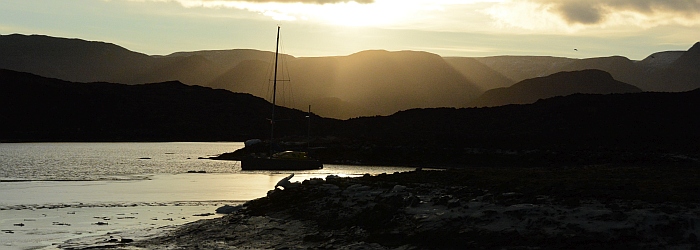
Our mooring at 'Stormy Bay', the day
before the storm (photo Kalle Schmidt)
With what we have seen this night, everything we feared for
before seems to be of no importance. We change tactics: we
become nomads again and will have a North and a South mooring
where we can retreat to, in case a storm approaches. We continue
to explore our surroundings and discover a perfect, tiny bay.
We ask ourselves if it has not been our wish that has led
to the existence of this place, which we had not seen two
weeks earlier when we passed close by.
Nanuq is now securely moored with two solid landlines to
the North and two to the South. The length of our full mooring
material is just enough! We have no desire to do rounds again
in the chaos of a storm, which without doubt will come...
|  Moorings
Moorings
Harward Oer 77°29.5'N 66°33,5'W : there are
numerous mooring possibilities in this natural harbour
which is situated between the two main islands of Harward
Oer. The bay we unofficially call 'Nanuq's Cove' can
only be used with landlines. Protection from S-ales
is good, from the North slightly less. Winds from E
and W are moderate. There are several drying rocks in
the center of the bay. Further inside the ground is
not deep enough. Therefore it is convenient to attach
two landlines to the N and two to the S, close to the
entry of the cove. Strong straps (such as used on cargos)
are perfect to make a good anchor around big rocks.
200m of mooring line are advised. The depth in the entry
is around 3m. There is a deep lake at about 1km to the
SE, with clear fresh water to fill up fresh water tanks.
The landscape is breathtaking with many different hiking
possibilities. The distance to the village, Qeqertat,
is 2.5km in a straight line, but you need a dingy to
cross the bay (if not frozen).
Spring tides are of about 3m, half for neap tides. |

Qaanaaq
region : 77° latitude North © worldwind
NASA bluemarble 2014
New
photo walls (September 28th, 2015)

Nanuq moored close to Qaanaaq as seen
from the Hotel
Qaanaaq (photo © Hans Jensen)
A last share before leaving Qaanaaq ...
Cheers,
Peter & crew
Autumn
2 : The last straight line (September 26th, 2015)
Stormy night in Qaanaaq. The gusty wind form the N blows
with up to 40 knots falling down the steep hills over Qaanaaq.
The mooring is exceptional, fortunately the ground has excellent
hold. Thanks to our 40kg anchor and 50m of 12mm chain, the
boat takes every stormy gust and our igloo stays a haven of
peace faced against the wind and weather. The nearly full
moon shines a dim light on the icebergs that slide by our
window down the fjord and the dust and snow is blown of the
hills against the twilight.
Two cables ahead the lights of Qaanaaq glow with encouragement.
Yes, this improbable place is well inhabited. Hostile at a
first glance, these two weeks that we have stayed here have
made us understand what it is that people appreciate here.
Without doubt, we are facing one of the most beautiful views
of the world. Hans Jensen, owner of the welcoming Hotel
Qaanaaq confirms this to us - the view from the Hotel
is exceptional. Regarding the organisation of the day to day
life, it is done without rush and with respect towards the
natural rhythm. There is no reason in rushing one step ahead
or to force the impossible. Here time is taken into consideration
and there is always a moment for community.
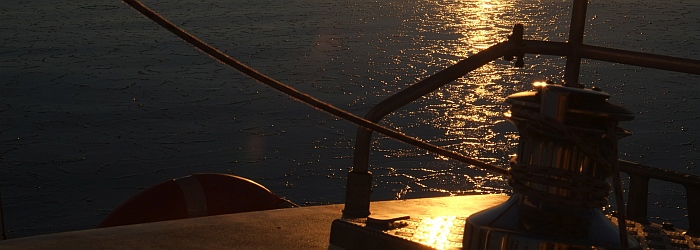
First ice forming on the sea-water - early pancake ice - nanuq
(photo Jakob Gallinelli)
We feel welcomed and we try to honour te welcome that is
given to us by giving back as much as we can. The opportunities
are numerous to exchange and learn from one another, be it
while buying supplies, organising the rest of the stay, visiting
the school, etc. And so friendship comes to be. We are very
grateful for this kind welcome from these friendly people
of Qaanaaq, the uncountable times we have been helped, and
all the good advice that we have received all along our way!
Yes, this country-continent (much more than just an island)
is magical, its geography as well as its people. We have much
to learn.


Greenlandic tradition: collecting ice to produce drinking
water from pollution-free thousand year old ice (photos Peter
Gallinelli)
Yesterday we received the good news: we have the green light
from the government and the local authorities to install ourselves
for the winter on the Greenlandic territory, here in the Qaanaaq
region. As for now, the road is clear: except for the last
correspondence with the rest of the world for some time, everything
is ready. The internet connection that has allowed us to reach
out to everybody will be cut for long months to come. A true
detox awaits us. We have learned to be autonomous - nonetheless
we will have to rediscover the use of paper post, which will
be delivered by dog sledge, and what it means to wait for
a reply. But don't worry, the blog will be kept up to date
by a combination of technology and old school techniques:
a memory stick in a letter! That way we'll keep you up to
date, like a friend of ours said: 'it's a kind of combination
of the old fashioned way and modernity to achieve efficiency'.
And going the other way - you may write a few lines here.
Very soon Nanuq will moor her anchor in a perfect little
bay on Harward Oer. She will transform into the igloo she
was designed to become - in the true sense of the Greenlandic
word: our home. The ocean swell, the gales and the uncertainties
of navigation are over for this season. They give place to
a new chapter, the apprenticeship of the cold: a long open
road that we follow forward; under the watch of the inhabitants
of the region, who warmly welcome our initiative. An opportunity
to live life...
Those of you who read these lines, we wish you a beautiful
autumn and we'll talk to you through the next post in some
time.
See you soon,
Peter & Crew
Autumn
1 : Inglefield Bredning - Queqertat (September 15th,
2015)
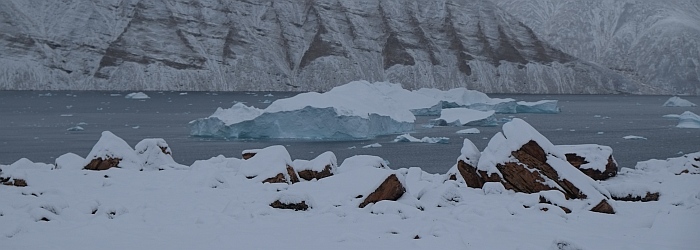
Bowdoin Fjord, end of season, Qaanaaq region, Greenland (photo
Peter Gallinelli)
If you can read these lines, it means that we have arrived
back in Qaanaaq and the 3G connection works, unexpected but
appreciated! We hope to be able to stay overnight at this
exposed mooring in front of 'the capital' for our last technical
touch down before heading to our winter camp...
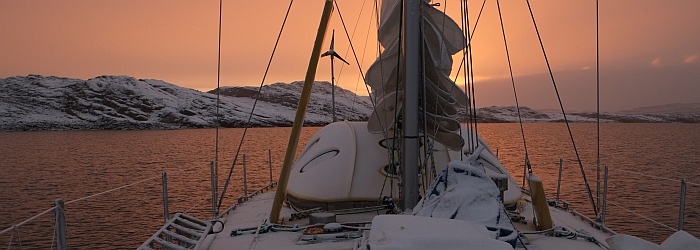
Nanuq mooring at Harward Oer (70°30'N); sunset after the
snowfall (photo Peter Gallinelli)
Ingelfield Bredning, 80 miles long and 10 miles wide, is
the biggest fjord in the NW of Greenland. Covering a surface
as big as Switzerland, it is home for about 800 people settled
in a handful of villages, Siorapaluk being the northernmost
in the world. 600 live in Qaanaaq - an artificial town installed
by the American army in the 50s to displace those living in
Dundas and Pitufik. The main activities of the local population:
hunting and fishing...
Qaanaaq is also a crucial point for many expeditions. We
meet Hans Jensen, the owner of the Qaanaaq Hotel. On the walls
of his establishment he shows us endless pictures of expedition
teams who stayed with him for a few days. We find nearly everything
we need, but we have to anticipate. The supply ship only passes
twice a year. Right now, the Arina Arctica lies anchored
before the town. The lighter travels back and forth between
the cargo and the coast unloading two containers at a time.
It is a long process as they can only work at high tide. The
inhabitants are joyful: new stocks for the store and for some
there is even a new outboard motor. The empty containers and
used machines are ready to travel back to Denmark.
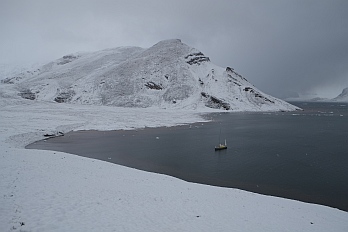
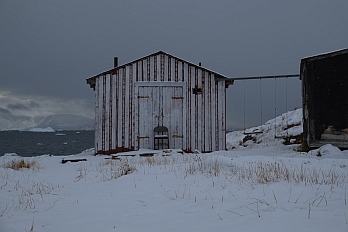
Anchorage at Kangerdharssuk. First snow September 11th, 2015
(photos Peter Gallinelli)
After a technical stop and with the permission of the local
administration we start our exploration of the fjord. The
temperature has dropped below 0°C. The wind blows and
it snows. The landscape, mineral and coloured, is now covered
by a white blanket. Winter magic! The helmsman, watching out
for drift ice, is warmly dressed with warm clothes and a ski
mask.


Helmsman in the snow. Rock formations close to Qaanaaq (photos
Dolores Gonzalez)
We make our way towards Harward Oer, an archipelago that
seems to offer several little bays where we might find a safe
mooring, maybe even for the winter. It is a natural harbour,
8 miles long, protected by an island to the N and S. Our hopes
are exhausted: there are several good moorings, well protected
from the sea and the ice.
To our surprise, the flora is abundant. It is late in the
season, the different plants are pulling back into their roots.
Between the rocks, the ice and the snow, these little green
valleys offer a hospitable contrast. It is certainly no coincidence
that humans have installed themselves here. 4families live
in the little village of Qeqertat. They prefer the calm lifestyle
close to nature over the busy 'city' life. Still there is
regular contact to Qaanaaq (the 'big' city).

Map of the region (© Kort & Matrikelstyrelsen, Miljoministeriet,
Danmark)
Maybe it is here that where we will install ourselves for
the winter. Except for absence of an Internet connection,
all the essential qualities can be found here. It starts by
a good mooring, protected from the sea and the ice but not
to closed in so we can still profit from the wind. And even
though the language barrier was there, the first contact with
the people of Qeqertat was warm and friendly.
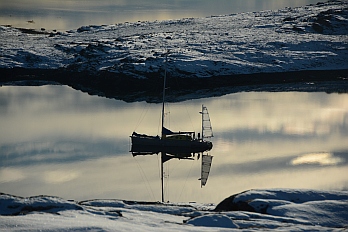
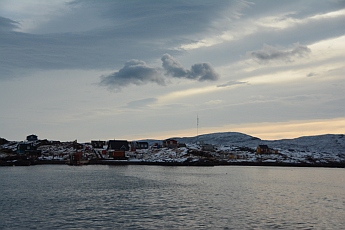
Nanuq mooring at Harward Oer, maybe our winter camp. The village
of Qeqertat seen from the W (photos Kalle Schmidt)
As for now we're heading back to Qaanaaq. Once more, we're
mooring in the red waters of Kangerdharssuk, protected from
the S wind blowing with up to 30 knots. Summer is over. Like
the migratory birds follow the flow of the seasons, it is
time for some of us to head S. The small twin engine only
flies once a week. Behind stays a small crew and exciting
adventure to come!
|  Moorings::
Moorings::
ATTENTION : sailing to the E of Qaanaaq requires a
special permission. Ask at the Kommunia for help. It
is also recommended to look out for any hunters on the
water, as to avoid disturbing them in their activities.
Kangerdharssuk (77°33'N 68°35'W): anchorage
in 15m sandy/muddy ground. Good hold to the S of the
delta. There is just enough space to swing around the
anchor with reasonable distance to the shore (20-40m).
Good protection except from the N to E. In SE gales
ice drifts into the bay. In this case; a temporary anchorage
may be found on the opposite shore of the fjord below
the mountains at the S end of the delta - very steep
but good hold. Rich flora. There are a few huts used
by local hunters and rests of a disused village. Easy
access to the Piulip Nunaa ice cap. Alpine landscape.
Harward Oer (77°29.5'N 66°29.3'W): the anchorage
is situated 2.5 miles to the E of Qeqertat. Good hold
in sandy/muddy ground. Protected from the ice and the
heavy sea in all directions, but not sheltered from
the wind because of the low surroundings. Stay in the
middle to cross the bay that separates the N and the
S island. Depths not less than 10m. For the approach
from the W: Round the S of the little islets (77°29N
66°42W) close to the village of Qeqertat. Access
to the mooring from the N. 45min hike to the highest
point of the archipelago (numerous little fresh water
lakes).
Harward Oer (77°30.4'N 66°24.6'W): excellent
mooring in a closed bay 4M to the E of Qeqertat. Depths
between 8 and 25m. Good hold in sandy/muddy ground.
The best protection from southerly winds can be found
to the S of the bay, just to the W of the entry passage
(moor in 15m depth and tie two land lines to the rocks
to the S). Keep clear of the drying rocks all around
the shore at a distance of 20-40m.
Caution: underwater rocks to the SW of the entrance,
aprox 50m from the shore. Green landscape. 15min hike
towards the E to a high point with a view onto the vast
end of the fjord.
Info:
Communication in the region on VHF channel 10. |
|